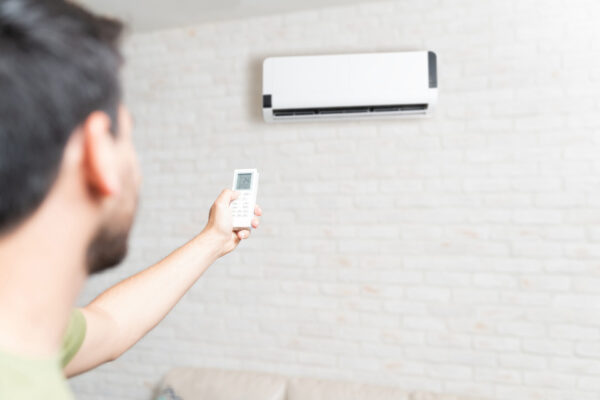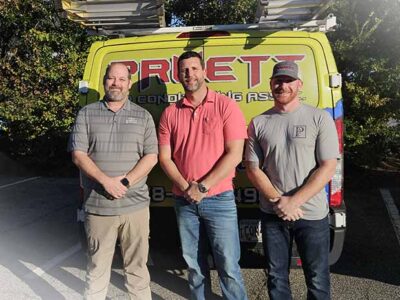
Ah, central heating and air – the thing that makes summertime survivable and winter a lot more comfortable. Central heat, the idea of having a single heat source that distributes warm air across an entire building, is an old idea – even the ancient Greeks and Romans had perfectly serviceable (if not terribly efficient) central heat.
In the 20th Century, the concept became more useful for those of us who live in warmer climates with the addition of air conditioning to the central heating system to create what we now call a heating, ventilation, and air conditioning (HVAC) system. Modern HVAC systems come in a wide variety of form factors – physical layouts – and use a number of technologies to keep your home comfortable.
In this article, we’ll examine the different types of residential HVAC systems and explain two ways they can be categorized and understood.
Types of HVAC System by Heating/Cooling Technology
HVAC System Type #1: Furnace-and-AC
This type of HVAC system is the classic heating-and-air combination that most homes in the US used until the 1990s. In a furnace-and-AC system, cooling is provided by a standard air conditioner (see our recent article on how air conditioners work to understand that technology), and heating is provided by a gas, oil, electric, or other type of furnace.
These units tend to be less efficient than a heat pump and have long been out of favor in the southern US, where summers are blistering but winters tend to be extremely mild. The advent of higher-efficiency heat pumps that can keep homes warm even in a bitter Minnesota winter means that these units are falling out of favor in colder climates, too.
HVAC System Type #2: Air-Supply Heat Pump
The most common type of unit being installed today is the air-supply heat pump. And no, it’s not named after a soft-rock band of the 1970s and 80s – the name refers to the fact that the unit’s source of heat is the outside air. Instead of relying on a furnace burning gas or oil to heat the home in the cooler months, a heat pump uses the air conditioner.
Yep, you read that correctly. An air conditioner doesn’t really “make cold.” You can’t make cold because cold doesn’t exist – it’s just a word we use to describe something that isn’t hot. All an air conditioner does is take heat out of the air inside your home and move it outside. In the winter, a heat pump runs “backward,” using the same hardware and refrigerants to pull heat from the air outside (even cold air contains a LOT of heat) and pump it into the home.
You can read more about how heat pumps work in our article “5 Things You Should Know About Your Heat Pump.”
HVAC System Type #3: Geothermal Heat Pump
For the ultimate in eco-friendly, efficient heating and cooling, an increasingly popular option is the geothermal heat pump. While more costly to purchase and install, a geothermal system uses only a fraction of the energy of other heating/cooling technologies. Instead of using the outside air as a heat source and a traditional evaporative air conditioner as a cooling source, a geothermal heat pump uses the Earth as a source for both.
Here’s the thing about the Earth – its surface is covered with soil, rocks, and water – all three of which are excellent insulators and hold heat like crazy. What does that mean? It means that summer’s heat takes a very long time to heat the soil, rocks, and water that exist even a few feet below the surface. It also takes a very long time for them to cool back down once winter starts.
A geothermal heat pump uses a series of long metal pipes that are buried deep underground and connected to the heat pump. By circulating water through those pipes and then through a heat exchanger, the pump moves heat from your home to the ground in the summer and from the ground to your house in the winter.

Types of HVAC Systems by Form Factor
HVAC System Form Factor #1: Split Unit
For new construction, the split unit is still the #1 preferred form factor for HVAC systems in homes in the US. A split unit has two separate assemblies – one outside the house and one in the home’s crawlspace or attic.
The outside unit contains the air conditioning compressor, condenser, and large condenser fan, as well as the associated wiring, plumbing, and controls. The inside unit, usually called the “air handler,” contains the air conditioner’s evaporator and the blower that introduces cool/warm air into the house. The two units are connected via a pair of refrigerant pipes or hoses and control wires.
HVAC System Form Factor #2: Ductless Mini-Split
This form factor for HVAC units is a relatively new addition to the HVAC world, and these systems are all based around air-supply heat pump technology. A mini-split unit is excellent for cooling small spaces, setting up independent “climate zones” inside a larger home, or retrofitting into homes that can’t readily accept a split unit or ductwork.
The mini split is just like a full split, but the air handler unit actually goes inside the room, installed in an attractive case that’s mounted to the wall or ceiling. Other than drilling one hole in the wall for the refrigerant and electrical lines to pass through, no modifications are required to the home.
HVAC System Form Factor #3: Package Unit
In a package unit, everything except the ductwork and thermostat is contained in one large metal cabinet that’s placed outside the home and connected directly to the ductwork. The main advantage of a package system is convenience and ease of installation—if you’re replacing an existing central air unit and already have ductwork installed, installation can usually be completed in just a couple of hours.
These outdoor package units are considerably larger than the small outdoor units seen on most split systems, so not everyone loves the way they look. Package units also suffer a small efficiency hit: with the air handler/blower outside the house, the blower has to work harder to effectively heat and cool the home, which can lead to slightly higher energy bills over a comparable split unit.
The Team at Pruett Air Conditioning Can Help You Decide on a New HVAC System or Replacement!
Need more comfort? Has a broken, old, or inefficient AC got you down? We can help. Our skilled technicians can evaluate your existing AC system and recommend a new unit that gives you top performance and top efficiency. Give us a call at 478-953-4986, and breathe easier!
Pruett Air Conditioning has offices in Warner Robins and Eastman, GA, so no matter where in Middle Georgia you’re located, Pruett is your local HVAC company.
- Bonaire, GA
- Byron, GA
- Centerville, GA
- Cochran, GA
- Dublin, GA
- Eastman, GA
- Fort Valley, GA
- Kathleen, GA
- Macon, GA
- McRae, GA
- Perry, GA
- Warner Robins, GA

